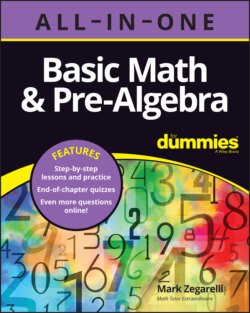Читать книгу Basic Math & Pre-Algebra All-in-One For Dummies (+ Chapter Quizzes Online) - Mark Zegarelli - Страница 77
Discovering your roots
ОглавлениеEarlier in this chapter, in the section, “Switching Things Up with Inverse Operations and the Commutative Property,” I show you how addition and subtraction are inverse operations. I also show you how multiplication and division are inverse operations. In a similar way, roots are the inverse operation of exponents.
The most common root is the square root. A square root undoes an exponent of 2. For example,
You can read the symbol either as “the square root of” or as “radical.” So read as either “the square root of 9” or “radical 9.”
As you can see, when you take the square root of any square number, the result is the number that you multiplied by itself to get that square number in the first place. For example, to find , you ask the question, “What number when multiplied by itself equals 100?” The answer here is 10 because
You probably won’t use square roots much until you get to algebra, but at that point, they become handy.
Q. What is 34?
A. 81. The expression tells you to multiply 3 by itself 4 times:
Q. What is ?
A. 1,000,000. Using the power of ten rule, is 1 followed by six 0s, so .
Q. What is ?
A. 6. To find , you want to find a number that, when multiplied by itself, equals 36. You know that , so .
Q. What is ?
A. 16. To find , you want to find a number that, when multiplied by itself, equals 256. Try guessing to narrow down the possibilities. Start by guessing 10:
, so is greater than 10. Guess 20:
, so is between 10 and 20. Guess 15:
, so is between 15 and 20. Guess 16:
This is correct, so .
19 Solve these exponents.
(a)
(b)
(c)
(d) (Hint: You can make your work easier by using the answer to c.)
20 Solve these exponents.
(a)
(b)
(c)
(d)
